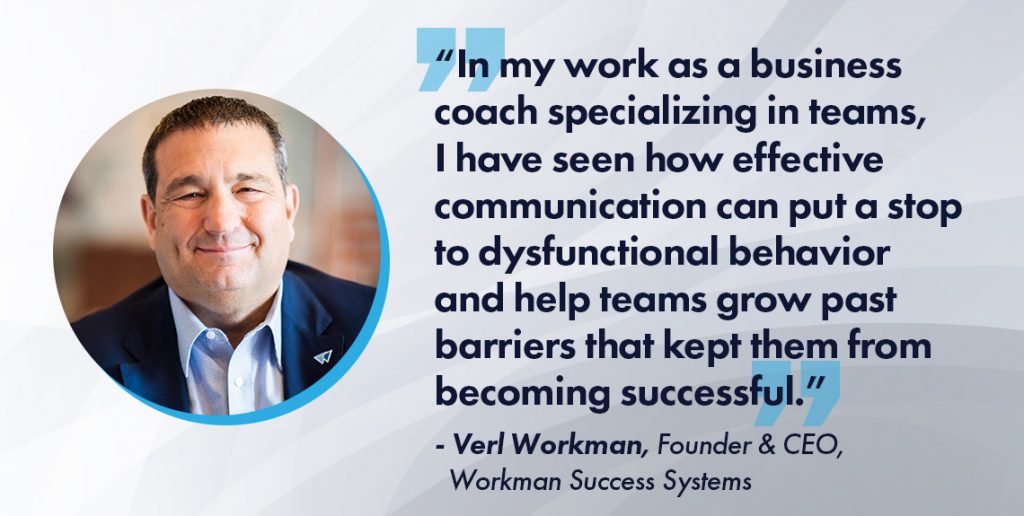A national study on teams in real estate commissioned by Workman Success Systems found that real estate professionals overwhelmingly feel that:
- Teams are the future of real estate
- Poor communication is the biggest barrier to establishing a strong team
“In my work as a business coach specializing in teams, I have seen how effective communication can put a stop to dysfunctional behavior and help teams grow past barriers that kept them from becoming successful,” says Verl Workman, founder and CEO of Workman Success Systems.
Workman recommends three things a team leader can do to start communicating more effectively with their team:
- Schedule accountability meetings. Accountability is not optional. Meeting regularly with your team is an opportunity to stay in touch with their goals, their productivity and—most important—their plans to get where they want to go. In your regular touchpoints with team members, ask the hard questions about what they are doing to get where they need to be. In the end, accountability is love, because it shows that you care how your team members are doing and how they are growing.
- Celebrate successes and recognize talent. How are you celebrating wins? Is it public? Do people on your team know when others do well? Do they know what others are doing well? This may not sound like communication, but an increase in recognition builds community and trust, which are two massive factors in improving communication channels and openness on a team. If you want them to open up and communicate, celebrate your team and recognize their talent and contributions.
- Hold daily huddles. Daily huddles are where community and culture are built. They are the perfect time to rally your team, encourage communication, increase accountability and celebrate wins. If you want to have a communicative team, you must provide opportunities for them to communicate—and huddles are among the best strategies for doing so.
“I’ve heard every excuse for why a team doesn’t have time for daily huddles, but I have never seen a good substitute for what they offer,” Workman says.
While fostering effective communication is one thing to tackle, the methods through which your team members stay in touch is a whole other ball game. Real estate is a busy life to lead, and team members are sometimes based in multiple areas, so the individuals who work on your team won’t always be able to meet and speak face to face.

“We are on the phone with each other often, and we are all tagged on every email, so any one of us is knowledgeable and accessible to any one of our clients at any time,” says Leslie Marshall, the Cornell Marshall Team with Corcoran Real Estate in Brooklyn, New York. “It may seem casual, but we are supremely organized in ways that clients appreciate—so much so that the major part of our business comes from referrals.”
When it comes to staying closely connected, virtual workspace apps can come in handy. In the modern technological era, you and your team have endless apps to choose from to help you streamline communication among team members:
Slack
Slack is an easy option for teams, because it is both easy and free, although the paid version offers many more features. Slack allows you to create different chat threads to split up topics, allowing for better communication. The app has even incorporated ChatGPT functionality so that users can take advantage of the AI tech in their messaging as well as in research. The only downfall is a lack of video chat availability to host meetings within the app, so you may need to use Zoom or a similar video chat in conjunction with Slack.
Google Workspace
Google’s suite of communication tools, dubbed Workspace, is a great option that has more functionality than Slack. Google Chat allows you to create spaces (similar to Slack’s chat threads) and chat between team members. Chat works with Google Meet, a video chatting service that can be used for meetings between team members. Workspace also allows file-sharing through shared drives. The advantage to using Google Workspace is that it hooks directly into all Google accounts, making it a perfect choice for teams that are familiar working with Google products over Microsoft. Creating a Workspace for business is a paid service, but plans start as low as $6 per user, per month.
Microsoft Teams
Speaking of Microsoft, Teams is one of the quintessential communication tools for workplaces around the world. For teams that are fans of Microsoft apps, this is the one to choose. Fairly similar to Google Workspace, Teams hinges on Microsoft apps. It has also been around longer, so it has a bit more experience within its functionality. Teams allows for conversation threads and video chatting, hooks directly into team members’ Outlook accounts and connects all Microsoft apps for file sharing. Like Google Workspace, Teams is a paid-only service, but plans begin as low as $4 per user, per month.
“There are simple ways to be sure you leave no one behind,” says Element Group’s Janni. “I assign my agents to ‘buddy up’ to our newer agents. They check in with them every week to see if they need anything or have any questions. Sometimes, a newbie is more receptive to a one-on-one conversation, whereas they hesitate to speak up at a team meeting.”



